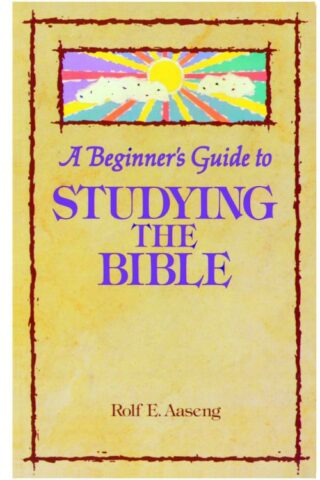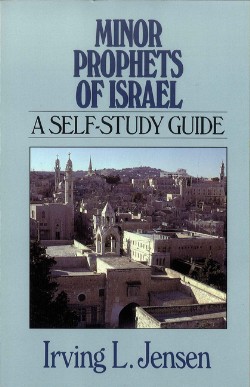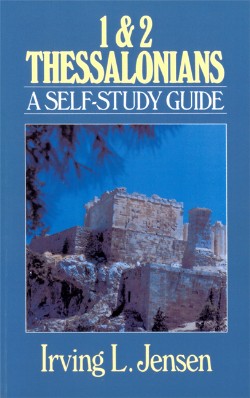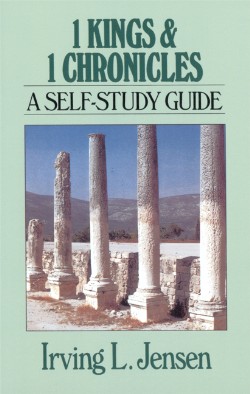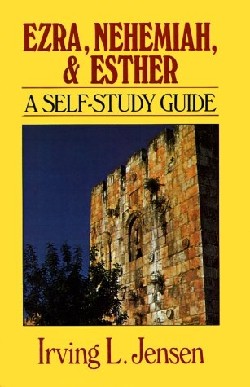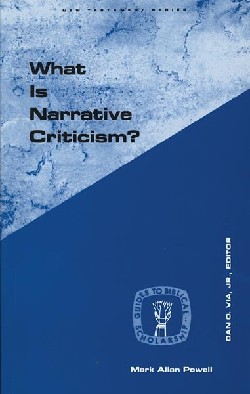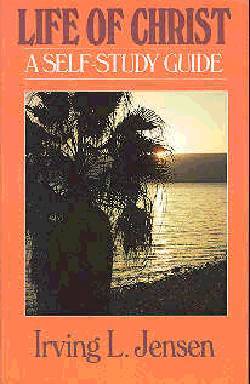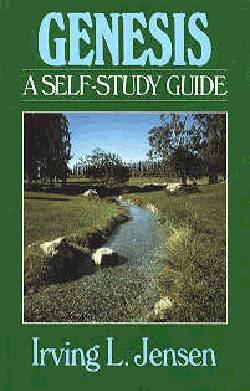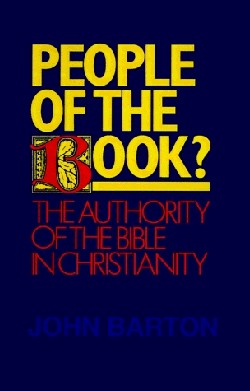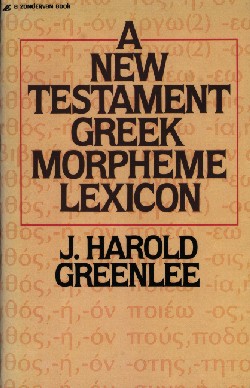Bible Language Tools
Showing 201–261 of 261 resultsSorted by latest
-
Beginners Guide To Studying The Bible
$12.99Add to cartDo you need help in studying a book or a smaller section of Scripture? The author provides help in using “tools” for Bible study such as commentaries, concordances, and atlases; he shows how to get the whole picture about a particular Bible passage; he describes basic methods of Bible study; he gives guidance on making application to life.
-
Leviticus : A Self Study Guide
$11.99Add to cartHas the book of Leviticus been difficult for you to study? Have you wondered what relevance this ancient book has to the New Testament Christian? This self-study manual will guide you into a new understanding of and appreciation for one of the most important books of the Bible. As you study, you will be brought face to face with the holiness of God and the sinfulness of man. You’ll gain fresh insight into God’s requirements for cleansing and fellowship with Himself through the sacrificial system, which pointed to the future finished work of the Lord Jesus Christ at Calvary.
-
Language And Logic Of The Bible
$41.99Add to cartThis study looks at the assumptions within which students of the Bible in the West approached their reading, from Augustine to the end of the twelfth century, when new skills in grammar and logic made it possible to develop more refined critical methods and to apply fresh tools to the task.
-
2 Kings 2 Chronicles (Student/Study Guide)
$9.99Add to cartExploring the Bible’s message is easy and exciting with this complete do-it-yourself Bible study guide on 2 Kings and Chronicles. Each study includes helpful outlines, charts, maps, diagrams and explanations. For personal, group or classroom use.
-
Myth Of Innocence
$39.00Add to cartPreface
Introduction: Christian Origins And The Imaginations
Part I: Christian Beginnings
1.The Temple And The Land Of Palestine
2.Jesus In Galilee
3.The Followers Of Jesus
4.The Congregations Of The Christ
5.The Patterns Of Social ConflictPart II: Stories In The Gospel Tradition
6.The Parables Of Jesus
7.The Pronouncement Stories
8.The Miracle StoriesPart III: Narratives Of The Passion
9.The Entanglements Of History And Myth
10.The Narrative Designs
11.The Compositional ProcessPart IV: The Gospel According To Mark
12.The Gospel As Myth
13.The Gospel As Apocalypse
14.The Gospel As Parable
15.The Gospel As ParadigmConclusion: Imagination And The Myth Of Innocence
Apendices
I. The Pronouncement Stories In Mark
II. Linnemann: The Traditions Of The Passion
III. Dormeyer: The Acts Of The Martyr
IV. The Gospel Of Mark: An OverviewBibliography
Indices
I. Subjects
II. Ancient Authors And Writings
III. Modern Authors -
1-2 Thessalonians : A Self Study Guide (Student/Study Guide)
$9.99Add to cartAlthough the apostle Paul was in Thessalonica only a short time, his teachings had an enormous effect on the young believers living there. His first letter was both a reminder of what he had taught them and a call for each believer to be prepared for the imminent return of Christ. In his second letter you will see how Paul handled misunderstanding and anxiety regarding the Day of the Lord. This Self-Study Guide will be an indispensable aid as you study Paul’s letters to the Thessalonians.
-
1-2 Peter (Student/Study Guide)
$9.99Add to cartContents
Introduction
1. The Man Peter
1 PETER
2. Background And Survey Of 1 Peter
3. Suffering And Salvation
4. The Christian Pilgrimage
5. God’s Chosen People
6. Life Of Subjection
7. A Christian’s Attitudes In Suffering
8. Suffering And Glory2 PETER
9. Background And Survey Of 2 Peter
10. The Man Who Knows God
11. True And False Prophecy
12. A Final Exhortation
Geography Of 1 And 2 Peter
Bibliography P. 99Additional Info
1 & 2 PETERIf you’re experiencing trials you will find encouragement and comfort in the epistles of Peter. Writing to believers who were being persecuted for their faith, Peter shows how trials are an important part of spiritual development in the individual. This self-study guide will also help you explore Peter’s practical guidelines for handling everyday responsibilities relating to the church, the home, and the world. In his second letter Peter reveals God’s design for the future, including a graphic description of the destruction of the earth.
-
Book Of Letters (Anniversary)
$26.99Add to cartFolktales about and exploration of the mystical meanings of the twenty-two letters of the Hebrew alphabet. Weaving talmudic commentary, Hasidic folktales, and kabbalistic mysteries around the letters, each letter is illuminated and is presented in the author’s original calligraphy.
-
God Language And Scripture
$18.99Add to cartThe primary aim of God, Language and Scripture is to provide guidance in the use of biblical languages. Secondarily this volume initiates the reader to the wonders and workings of language and points out how language is often misused, especially in regard to the Bible. This volume, however, in no way anticipates all the ways of mishandling language. Silva’s emphasis is on “global” rather than detailed concerns (though selected specific examples are used) of how language is misused. The book includes an account of the birth and growth of modern linguistics, an appreciation of its interdisciplinary character, particularly its ties with literary criticism, sociology, anthropology, psychology, and science. It surveys all levels of language description, but emphasizes the semantic and stylistic aspects of grammar and syntax, vocabulary, and discourse. In addition, it considers the transmission of the Bible (textual criticism and translation) as a mode of linguistic communication and interpretive process.
-
What Is Narrative Criticism
$17.00Add to cartThis book is the first nontechnical description of the principles and procedures of narrative criticism. Mark Allan Powell distinguishes literary criti cism from various modes of historical criticism–source, form, and redaction–and also delineates several types of literary criticism–structuralist, rhetorical, reader- response, and narrative. He then describes, analyzes, and illustrates the categories that narrative criticism employs, such as implied author and reader, narrator, character, events, settings. Mark Allan Powell is Assistant Professor of New Testament and Director of Continuing and Post-Graduate Studies at Trinity Lutheran Seminary in Columbus, Ohio.
-
Beginners Guide To The Books Of The Bible
$12.99Add to cartBefore starting to read one of the 66 books in the Bible, it is helpful to have an overview of the book. This book provides accurate, concise, and easy-to-understand introductions to each of the 39 books of the Old Testament and 27 books of the New Testment. Each description discusses the book’s purpose, approximate date of composition, authorship, contents, and distinctive features. Also included are introductions to larger sections of the Bible, such as the major and minor prophets.
-
Beginners Guide To Reading The Bible
$12.99Add to cartMany of us would like to know more about the Bible, but don’t know where to begin. A Beginner’s Guide to Reading the Bible is a concise introduction that assumes no previous acquaintance with Scripture. The author provides an overview of the content of the Bible, a look at the kinds of literature it contains, describes how the Old and New Testaments were formed, discusses some commonly used English translations, and lists resources that can be helpful to beginning readers.
-
Galatians : A Self Study Guide (Student/Study Guide)
$9.99Add to cartExploring the Bible’s message is easy and exciting with this complete do it yourself Bible study guide on Galatians. Each study includes helpful outlines,charts,maps,diagrams and explanations. For personal,group and classroom use
-
Life Of Christ (Student/Study Guide)
$11.99Add to cartContents
Introduction
1. Before The Event Of Bethlehem
2. The Gospels’ Four Portraits Of Jesus
3. The Geography Of Jesus’ Public Ministry
4. Jesus The God-Man
5. Life Of Christ: A Survey
6. Preparation Period
7. Beginning Of Public Ministry Period
8. Early Judean Period
9. Early Galilean Period
10. Middle Galilean Period
11. Later Galilean Period
12. Later Judean. And Perean Periods
13. Passion Week
14. The Resurrected Christ
15. A Concluding Study
BibliographyAdditional Info
What would it have been like to know Christ during His life on earth? What was He really like? How can we live more Christ like lives? This Self-Study Guide follows Christ’s footsteps from birth to death and gives us a clearer understanding of His purpose for the world and for each of us as individuals. It shows us how to apply Christ’s teachings to our daily lives. -
Theological Dictionary Of The Old Testament Volume 6
$78.99Add to cartThis multivolume work is still proving to be as fundamental to Old Testament studies as its companion set, the Kittel-Friedrich Theological Dictionary of the New Testament, has been to New Testament studies.
Beginning with ‘abh (‘ab), “father,” and continuing through the alphabet, the TDOT volumes present in-depth discussions of the key Hebrew and Aramaic words in the Old Testament. Leading scholars of various religious traditions (including Roman Catholic, Lutheran, Reformed, Anglican, Greek Orthodox, and Jewish) and from many parts of the world (Denmark, France, Germany, Great Britain, Greece, Israel, Italy, the Netherlands, Norway, Sweden, Switzerland, and the United States) have been carefully selected for each article by editors Botterweck, Ringgren, and Fabry and their consultants, George W. Anderson, Henri Cazelles, David Noel Freedman, Shemaryahu Talmon, and Gerhard Wallis.
The intention of the writers is to concentrate on meaning, starting from the more general, everyday senses and building to an understanding of theologically significant concepts. To avoid artificially restricting the focus of the articles, TDOT considers under each keyword the larger groups of words that are related linguistically or semantically. The lexical work includes detailed surveys of a word’s occurrences, not only in biblical material but also in other ancient Near Eastern writings. Sumerian, Akkadian, Egyptian, Ethiopic, Ugaritic, and Northwest Semitic sources are surveyed, among others, as well as the Qumran texts and the Septuagint; and in cultures where no cognate word exists, the authors often consider cognate ideas.
TDOT’s emphasis, though, is on Hebrew terminology and on biblical usage. The contributors employ philology as well as form-critical and traditio-historical methods, with the aim of understanding the religious statements in the Old Testament. Extensive bibliographical information adds to the value of this reference work.
This English edition attempts to serve the needs of Old Testament students without the linguistic background of more advanced scholars; it does so, however, without sacrificing the needs of the latter. Ancient scripts (Hebrew, Greek, etc.) are regularly transliterated in a readable way, and meanings of foreign words are given in many cases where the meanings might be obvious to advanced scholars. Where the Hebrew text versification differs from that of English Bibles, the English verse appears in parentheses. Such features
-
Matthew : A Self Study Guide (Student/Study Guide)
$9.99Add to cartExploring the Bible’s message is easy and exciting with this complete do-it-yourself Bible study guide on Matthew. Each study includes helpful outlines, charts, maps, diagrams, and explanations. For personal, group, or classroom use.
-
General Introduction To The Bible
$22.99Add to cartThere are two strands woven together in the history of the Bible and its translations. One is the development of the biblical text: its materials, texts, and translations. The second is the story of the men and women who went to great extremes, at times risking death, in order to provide their generation with the Word of God in a language that could be understood. David Ewert skillfully combines both these elements in this informative and captivating book, beginning with what “Bible” means, how the Bible is organized, and how various books were named. He explores such other matters as the development of the biblical languages, the canon and the history of the testaments, and early versions of the Bible. English translations, from the time of Wycliffe to the present, are the focus of several chapters. A General Introduction to the Bible is filled with photographs of ancient texts, pages from various Bibles, photographs of key individuals and settings — all of which add understanding to the Bible’s history. Maps and charts show the development of languages, textual families, and the relationship of various translations and revisions. There are suggested readings and an extensive glossary and index.
-
Mark : A Self Study Guide (Student/Study Guide)
$11.99Add to cartContents
Introduction
1. Background
2. Survey
3. Jesus Came
4. Jesus’ Fame
5. Hostility Sets In
6. Ministries To The Disciples And The Multitudes
7. Jesus The Miracle Worker
8. Renewed Surge Of Opposition
9. The Turning Point Of Jesus’ Public Ministry
10. Concluding Ministries In Perea
11. Jesus As Lord
12. Events Prior To Jesus’ Arrest
13. Arrest, Trials , And Crucifixion
14. Resurrection And Final Appearances
Geography Of Mark
Bibliography P. 125Additional Info
Christ the servant is the basic theme of the gospel of Mark. Great care us taken to show the submissive attitude of Jesus Christ as He cares for the afflicted, heals the sick, and comforts the tormented. This Self-Study Guide points out the key verse (Mark 10:45), which divides the gospel into two parts – the service and the sacrifice of the Lord Jesus. By studying verse by verse this “book of action” you will experience what Christ did as well as what He said. -
Studying Interpreting And Applying The Bible (Student/Study Guide)
$24.99Add to cartStudying, Interpreting, and Applying the Bible combines into one volume the popular trilogy by Walter Henrichsen and Gayle Jackson: – A Layman’s Guide to Studying the Bible – A Layman’s Guide to Interpreting the Bible – A Layman’s Guide to Applying the Bible This book will help students as well as ministers, young people and old alike, as they learn to study Scripture more easily and conveniently. The chapters on studying the Bible help the beginning or experienced Bible student mine God’s Word for its riches through verse analysis, chapter analysis, the overview of a book, the study of a topic, and the study of Bible characters (including charts, diagrams, and other helpful illustrations). The unit on interpreting the Bible explains Bible interpretation based on grammar, history, and theology. The section on applying the Bible moves beyond study to life applications, enabling a person to – be motivated to make personal application – move beyond a “to do” list to an internal desire to obey – consider the risks involved in obeying – use specific application principles.
-
Ephesians : A Self Study Guide (Student/Study Guide)
$11.99Add to cartContents
Introduction
1. Background Of Ephesians
2. Survey Of Ephesians
3. Spiritual Blessings In Christ
4. Prayer For Spiritual Wisdom
5. Once Dead, Now Alive
6. Paul’s Testimony And Prayer
7. Preserving Church Unity
8. The Daily Walk Of Christians
9. Conduct In The Christian Home
10. The Christian’s Armor P. 96Additional Info
EPHESIANS
A Self-Study GuideDuring Paul’s imprisonment in Rome, he wrote many letters to churches and friends. Ephesians is one of those letters. Written to the believers at Ephesus, it speaks of the plan God has had from eternity to establish and complete His church. This self-study guide will help you understand a number of key topics in the book of Ephesians, among them predestination, the church, spiritual gifts, and spiritual warfare.
-
Romans : A Self Study Guide (Student/Study Guide)
$9.99Add to cartContents
Introduction
1. Introduction To Paul’s Epistles
2. Background And Survey Of Romans
3. Paul’s Burden
4. The Pagan World And The Self-Righteous Condemned
5. The Jew Condemned; The Whole World Condemned
6. Justification Defined And Illustrated
7. Fruits Of Justification
8. Principles Of Christian Living
9. The Practice And Power Of Christian Living
10. God’s Sovereignty In Saving Jew And Gentile
11. The Christian Servant
12. The Christian Citizen
13. The Christian Brother
14. Epilogue: Personal Notes
Bibliography P. 115Additional Info
ROMANS: A Self-Study GuideTo understand the deeper truths of the Word of God, study the book of Romans. Paul’s letter reveals one important theological truth after another, laying a foundation for the Christian faith. By using this self-study guide you will be able to apply basic Bible doctrine to your everyday Christian experience. You’ll understand more fully subjects such as justification, propitiation, the universality of sin, and the characteristics of the new life in Christ.
-
Acts : A Self Study Guide (Student/Study Guide)
$11.99Add to cartContents
Introduction
Geography Of Acts
1. Background Of Acts
2. Witnesses For Jesus
3. The Holy Spirit Poured Forth
4. A Miracle And A Sermon
5. The Test Of Conviction
6. More Tests And Victories
7. Stephen The Martyr
8. Philip The Soul-Winner
9. Conversion Of Saul
10. The Gospel For Gentiles
11. Antioch Christians
12. First Missionary Journey
13. Jerusalem Council
14. Second Missionary Journey
15. Third Missionary Journey
16. Paul Before The Mob
17. Paul Before The Council
18. Paul Before The Governors
19. Paul Before A King
20. Voyage To Rome
21. Paul’s Witness At Rome
Index Of Topical Studies
BibliographyAdditional Info
The book of Acts spans thirty years and is a record of the spread of Christianity from the coming of the Spirit on the day of Pentecost to Paul’s arrival in Rome. This self-study guide will enable you to understand the formation and the development of the church. Patterns of church life and principles for missionary work are among the topics discussed. If you are looking for a comprehensive, challenging tool to use in personal, group, or class Bible study, you’ll find the Jensen Bible Self-Study Guide series an exciting way to better understand the important truths of God’s Word. Each response-oriented guide in the 39-book series features helpful charts, graphs, maps, and ideas for projects and further study. You’ll refer back to each completed guide as a reference again and again as you study the Scriptures. This study series has enabled millions to effectively explore and understand God’s eternal message, and it continues to be the most widely used tool for Bible study today. -
Genesis : A Self Study Guide (Student/Study Guide)
$11.99Add to cart1. The Book Of Genesis
2. Creation
3. The Fall
4. The Flood; Birth Of Nations
5. Abraham-Four Great Tests
6. Abraham’s God Of Promise
7. Abraham’s Crucial Last Years; Isaac
8. Jacob Striving For Blessing
9. Jacob Learning True Blessing
10. Joseph As Prisoner
11. Joseph As Benefactor
12. Joseph As Son And BrotherAdditional Info
Genesis is the book of beginnings. In it we have the account of the creation of the universe and all that is within it. In the book of Genesis we see god putting into action the plan He has had eternally for mankind. This self-study guide will help you as you study each facet of God’s program through fourteen organized lessons. Charts, maps, and diagrams appear throughout the study guide and ill give you a greater understanding of this unique, foundational book of beginnings.If you are looking for a comprehensive, challenging tool to use in personal, group, or class Bible study, you’ll find the Jensen Bible Self-Study Guide series and exciting way to better understand the important truths of God’s Word. Each response-oriented guide in the 39-book series features helpful, charts, graphs, maps, and ideas for projects and further study. You’ll refer back to each completed guide as a reference again and again as you study the Scriptures. This study series has enabled millions to effectively explore and understand God’s eternal message, and it continues to be the most widely used tool for Bible study today.
-
New Testament Exposition
$22.99Add to cartExpository preaching is an elusive ideal. Many preachers aspire to it, few are acknowledged masters. For most a gap exists between the sermon that addresses the needs of the hearers and one that methodically plumbs the depths of Scripture. New Testament Exposition is written to bridge this gap and bring together the disciplines of preaching and exegesis. In this book Liefeld addresses the three main concerns of expository preaching: What is the text saying? How can its message be communicated in ways that are appropriate to the passage, the seeing, and the goals of the sermon? How can the message meet the real needs of the congregation in a way that is consistent with the purpose and function of the text? This book demonstrates how these concerns can be brought together in a sermon, and it is this thoughtful, practical approach that makes the book so valuable to preachers and seminarians. The book is divided into three parts. Part I explores the characteristics of expository preaching. Part II deals with preparing the text and addresses such areas as practical exegesis, exegetical outlines, narratives and compositional patterns, semantic patterns, and underlying assumptions of the text. Part III discusses application of the text by asking, What is the function of the text? What are the needs of the congregation? How can one preach to inner heart needs as well as to the external circumstances facing the congregation? New Testament Exposition is not vague theory, nor is it esoteric study beyond the grasp and time of the busy pastor. Throughout the book Dr. Liefeld reflects his experience in the classroom and pulpit, and his concerns as scholar and pastor are clearly seen in the final chapters of this volume. Chapter 9 examines preaching from difficult texts: How might one handle parables, miracle stories, obscure passages, culturally related texts? The final chapter provides a demonstration of all that is discussed throughout the book by walking the road through the actual preparation for a sermon.
-
People Of The Book
$30.00Add to cartIn this book, John Barton offers a positive but critical evaluation of biblical authority. Among other topics, he discusses the canon, the value of the Bible as historical evidence, the Bible’s witness to the faith, and the place of Scripture in worship. He shows Christians that critical reading of Scripture is a help rather than a hindrance to their faith and affirms that they are not required to chose between fundamentalism and unbelief.
-
Handbook Of Biblical Hebrew A Print On Demand Title
$53.99Add to cartThe Handbook, designed as a complete tool for the student of Biblical Hebrew, is the result of over twenty- five years of teaching the language. While it is primarily intended for use in Hebrew courses, it is also an excellent tool for a refresher course or useful as a basic grammatical reference work to aid the exegete. Similar in format to the author’s Handbook of New Testament Greek, it combines reading lessons (vol. 1) with grammar, paradigms, and basic vocabulary (vol. 2). William LaSor uses the inductive method, studying directly from the text, rather than the conventional method of language study in which beginning students learn the rules of grammar and syntax and memorize vocabulary, often without reading the actual text. Instead of memorizing numerous forms that will never be encountered in actual reading, the student learns only what he or she encounters.
The lessons are based on the Hebrew text of Esther, chosen because it presents little difficulty in theological or textual matters and has an excellent vocabulary. LaSor has included readings from other portions of the Bible, such as several chapters from Genesis, to introduce the student to Hebrew other than that found in Esther.
The diligent student of this method will learn not only the elements of Hebrew but also how to inductively study the language and how to learn by induction what the Hebrew text says.
-
Handbook On The Basic Bible Texts
$15.99Add to cartThis volume provides the complete text of key Scripture passages that form the basis for theological study. The text used is the highly readable and modern New International Version. The verses listed are grouped by the classical categories of systematic theology (e.g., God, Christ, Salvation); on disputed points, verses from which the major theological views derive are given. Footnotes provide clarification and brief commentary on verses as appropriate. This work is intended to assist the theological student who might not take the time to look up the verses cited in systematic theologies, but it will also be useful to anyone seeking to better understand the major themes of Scripture.
-
New Testament Greek Morpheme Lexicon
$21.99Add to cartThis New Testament Greek Morpheme Lexicon is a unique and valuable addition to the many reference tools now available to those who study and translate God’s Word. In this Lexicon words are analyzed so that students, professors, and translators can see at a glance all the morphemes and components (prefixes, root words, suffixes, and terminations) of all the Greek words used in the New Testament and other Christian literature. It is a systematic and complete presentation of the morphemes of all the words found in the second edition of the classic standard lexicon by Bauer-Arndy-Gingrich-Danker, A Greek-English Lexicon of the New Testament and Other Early Christian Literature. It is recommended because of the following special features and uses: – Part 1 gives prefixes, root words, suffixes, and terminations for every word in BAGD. – Part 2 lists every word that contains each of the morphemes identified in part 1, so that a morpheme can be observed in all the words that use it at a single glance. – English glosses are given as brief, tentative keys to meaning. – Creative research is made possible through these easy-to-use analyses. – Linguists and translators can trace the meanings and relationships of words in various combinations. – Students have a new help for learning and studying the language of the New Testament.
-
Understanding The Bible (Revised)
$24.99Add to cart1. The Purpose Of The Bible
2. The Land Of The Bible
3. The Story Of The Bible (Old Testament)
4. The Story Of The Bible (New Testament)
5. The Message Of The Bible
6. The Authority Of The Bible
7. The Interpretation Of The Bible
8. The Use Of The Bible192 Pages
Additional Info
This book answers foundational questions: Who wrote the Bible? What is its message? Why is it thought to be a “holy” book? How does one read and interpret it? Best of all, though, you’ll broaden your vision of Jesus Christ, the focal point of Scripture. How? By better understanding the geographical, religious, and historical concerns that shaped the world in which he lived. You’ll see Jesus as never before: both as a man of his times and culture, and as the culmination of a divine providence that prepared the way for the ministry of the Messiah. Written by renowned preacher, writer, and apologist John Stott, this new, expanded edition includes – Questions at the beginning of each chapter to help you focus – New, up-to-date maps for the chapters on history and geography – An index to help you speedily access areas of interest. -
Index To The Revised Bauer Arndt Gingrich Greek Lexicon
$24.99Add to cartThis revised edition of Alsop’s Index brings up to date a proven and valuable reference tool for translators, ministers, and students of New Testament Greek. The first edition was first produced by Wycliffe Bible Translators as an index to the entries in the Bauer-Arndt-Gingrich Greek Lexicon (BAG) and later published by Zondervan. Now that the second edition of BAG by Gingrich and Danker has appeared, the Index has also been completely revised and set in Greek type. Greek professors recommend the new Index because of these salient features: – Readable Greek type saves time for scholars and students. – Proficient students can double their speed in locating references in BAG. – Aids beginning students in learning to use BAG for careful exegesis. – Quickly locates the exact quadrant of the BAG page where the word and reference are treated. – English gloss gives quick reference to the general meaning of words. – Tells at a glance how BAG classifies a particular occurrence of frequently used words. – Eliminates laborious, line-by-line searching for references in BAG. – Highlights nuances of meaning for certain words by giving multiple references to BAG.
-
Do It Yourself Hebrew And Greek
$22.99Add to cartDo-It-Yourself Hebrew and Greek is designed for the serious Bible student who wants to discover as accurately as possible what the Bible meant in its original languages but who is not in a position to master those languages. The manual introduces the alphabets and the basic elements of Greek and Hebrew grammar. With this foundation, the student is taught to use the basic language tools, including analyticals, lexicons, interlinears, concordances, and commentaries.
-
New Testament Words
$25.00Add to cartThe Daily Study Bible Series of New Testament Words provides a useful volume for anyone’s study as it traces English words to their earlier Greek meanings.
The book contains sixty key Greek words used in the New Testament and lends itself to use as a handy addition to The Daily Study Bible series.
-
Grammatical Aids For Students Of New Testament Greek A Print On Demand Titl
$15.99Add to cartThis volume will prove very useful to those who already have, or are in the process of gaining, a basic knowledge of the principles of New Testament Greek grammar.
The charts and text included here will assist students in seeing the logical relationships between the various forms of the most important parts of speech included in the study of New Testament Greek. When students see the logical relationships that exist, their workload will be lightened; rather than memorizing hundreds of different forms, students need commit to memory only certain basic forms and only those principles that are necessary to construct other related forms – plus the exceptions to those principles and forms where they exist.
A further purpose of this work is to provide a refresher course for students who have already taken elementary Greek but find themselves in need of a simplified reference work.
-
Literary Criticism Of The Old Testament
$19.00Add to cartI. Introducing Literary Criticism
The Discipline Of Literary Criticism
Examples Of Literary CriticismII Discovering Literary Sources
Isolating The Evidence Of Genesis 1-5
Comparing The Evidence Of Genesis 6-9III Interpreting Literary Sources:
The Yahweh And The Promise
The Yahwist At Work: A Classic Passage
The Need For The Promise
The Patriarchs And The Promise
Moses And The PromiseIV Interpreting Literary Sources
The Priestly Writer And The Covenant
The Priestly Writer At Work
The Abraham Covenant Initiated
The Covenant Remembered In Egypt
The Structuring Of The Covenant
Relationship At SinaiGlossary
Annotated Bibliography
Additional Info
This well-written introduction to the method of literary criticism gives the reader an awareness and appreciation of the rich diversity of thought found in the Old Testament. The student is shown how to identify the elements of structure, style, form, language, and composition in the books of the Old Testament. Norman Habel demonstrates how literacy criticism works with examples which are familiar and well-suited for a beginner’s level of study. The literary features of Genesis 1-9 are fully explored, then the author focuses on the importance of the Yahwist and priestly sources for the whole Pentateuch. This book’s explanation of techniques used in the process of literary criticism will be valuable to both student and professor. -
Introduction To The Bible
$60.00Add to cartThis profusely illustrated book is doubly valuable! It introduces the reader to both the content of the Bible and to the life, faith, and history of ancient Israel, early Judaism, and early Christianity. The volume includes photographic illustrations, a full subject-oriented bibliography for further reading, and the Westminster Historical Maps of Bible Lands.
-
Parsing Guide To The Greek New Testament
$34.99Add to cartHere is a welcome tool for students who need some help in working their way through the Greek New Testament. It will save time in searching for forms in the current analytical lexicons. Only verbs and words that are characteristic of verbs are parsed. A verb parsing gives the person, number, tense, voice, mood, root, and meaning. This parsing guide follows the twenty-fifth edition of the Nestle-Aland Greek text. It was designed for use by seminary students, Bible colleges, New Testament scholars, ministers, and Bible translators.
-
Basic Bible Study (Student/Study Guide)
$8.99Add to cart8 Lessons
Additional Info
The Teach Yourself the Bible Series is one of the best New Testament studies you will find anywhere. Each book in the series is packed full of valuable questions on individual chapters of the Bible, check-ups to test your grasp of scriptural truths, and usable suggestions for group study.Grow your knowledge of God through each New Testament book, then go on to study six aspects of Christians, essential for all believers: doctrine, prayer, eternal life, prophecy, Christian character, and Bible study.
Strengthen your relationship with the living God with all twenty – five books of the Teach Yourself the Bible Series. Each volume is a timeless, yet practical, study of the Word of God.
-
Hebrew And English Lexicon Of The Old Testament
$214.99Add to cartBased on the seminal work in Hebrew lexicography, Gesenius’ Thesaurus, this lexicon offers the reader short English definitions, and, in cases of uncertainty, the means of forming an independent judgment from the extant materials and the extra-biblical history of the words. Words are classified according to their stems and no pronunciations are supplied. The comprehensive appendix containing the Biblical Aramaic makes use of important Aramaic texts from Egypt, of the fifth century B.C.
Based on the Lexicon of William Gesenius as translated by Edward Robinson
Edited with constant reference to the Thesaurus of Gesenius as completed by E. Rodiger, and with authorized use of the latest German editions of Gesenius’ “Handworterbuch uber das Alte Testament”, by Francis Brown
with the co-operation of S. R. Driver and Charles A. Briggs

